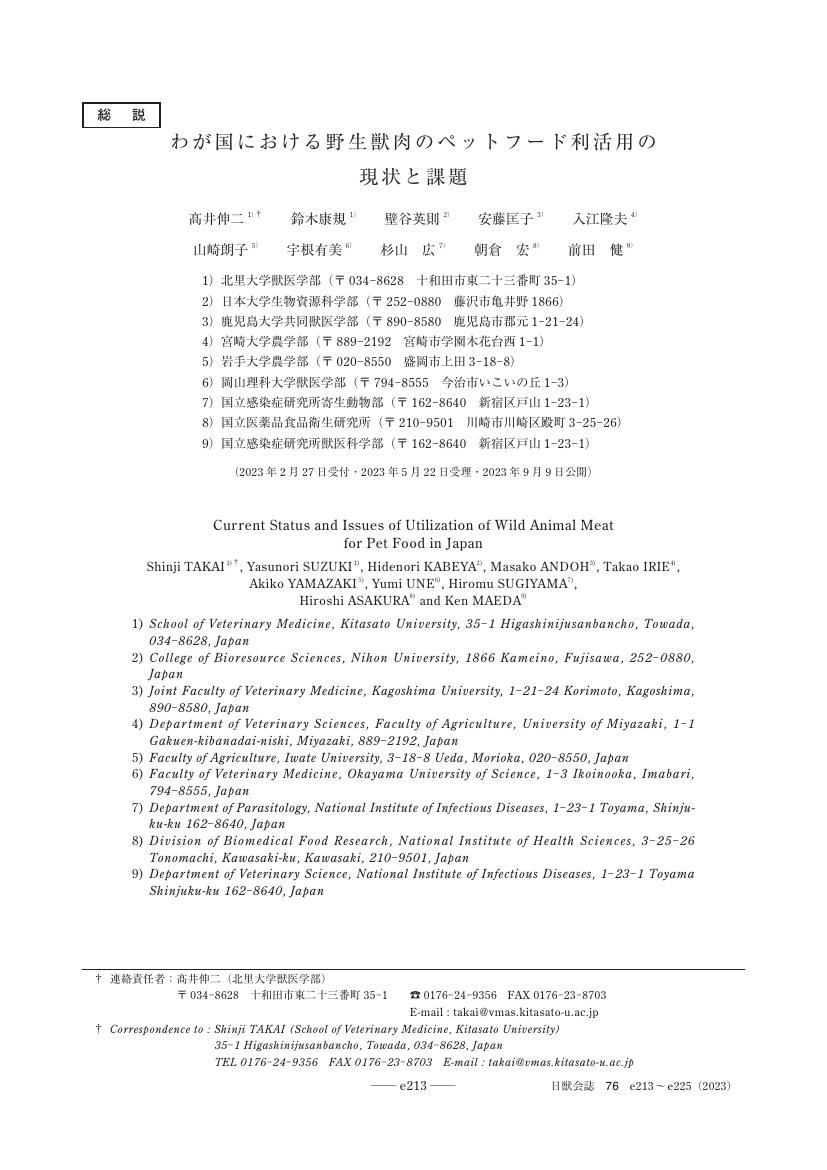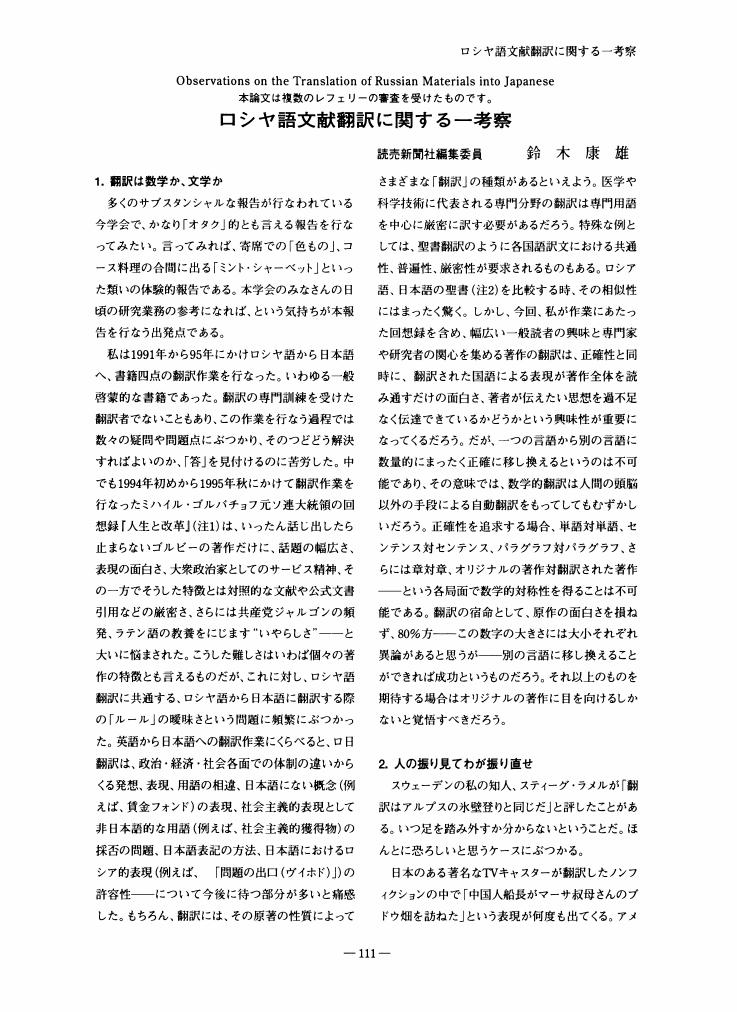2 0 0 0 OA 海底活断層から発生する大地震の予測精度向上のための変動地形学的研究
1 0 0 0 OA ジャトロファ油/灯油混合燃料を用いたコモンレール式ディーゼル機関の特性
- 著者
- 朝香 勝義 横川 和弘 小橋 好充 加藤 聰 鈴木 康允 Alberto MACAMO
- 出版者
- 一般社団法人 日本機械学会
- 雑誌
- 日本機械学会論文集 (ISSN:21879761)
- 巻号頁・発行日
- pp.14-00527, (Released:2015-03-18)
- 参考文献数
- 9
Oil derived from Jatropha is a potential alternative to fossil fuels for Diesel engines in Mozambique because it can be cheaper and more easily available than fatty acid methyl ester, though the physical properties, e.g. high viscosity, might be a problem. As an attempt to use Jatropha oil (JO) in Diesel engines, the present study mixed JO into kerosene. Engine tests as well as un-evaporating spray visualization were carried out. The results demonstrated that a single cylinder engine can be successfully operated with JO blended kerosene despite the fact that the ignition delay is slightly longer than diesel fuel. There were no significant changes of exhaust gas emissions. It is also clear that mixing JO into kerosene can contribute to the reductions of insoluble fraction and soluble organic fraction contained in particulate matter than mixing into diesel fuel.
1 0 0 0 OA わが国における野生獣肉のペットフード利活用の現状と課題
1 0 0 0 OA 1999集集地震による地震断層の位置と既存の活断層との関係
- 著者
- 太田 陽子 渡辺 満久 鈴木 康弘 澤 祥
- 出版者
- Tokyo Geographical Society
- 雑誌
- 地学雑誌 (ISSN:0022135X)
- 巻号頁・発行日
- vol.112, no.1, pp.18-34, 2003-02-25 (Released:2009-11-12)
- 参考文献数
- 24
- 被引用文献数
- 2 2
A remarkable surface rupture appeared in the 1999 Chichi earthquake, in central Taiwan. The nature and location of the earthquake fault was studied in detail immediately after the earthquake (e.g., Central Geological Survey, Taiwan, 2000). Its location to the pre-existing active fault trace, however, was unknown. We wish to establish a location relationship between the earthquake fault and the pre-existing active faults which are mapped from photo interpretation at a scale of 1 : 20, 000, taken in 1970's, supplemented by field observation. The identified active faults are divided into four types from I to IV, depending on their certainty as active faults as well as their location accuracy. A Type I fault is where the active fault is definite and location is certain, II is also an active fault, but with a little uncertainty as to exact location due to subsequent erosion of the fault sacrp, and also because of sedimentation on the foot-wall, and III is a concealed fault beneath the younger sediment. Type IV appeared as a lineament without any clear evidence of deformed morphology. After mapping these active faults, we added the location of our observation to the 1999 surface rupture and GPS sites for measuring the earthquake fault using CGS map (2000).We present eight areas to show the exact relationship between active fault trace and earthquake fault trace and summarized them into Fig. 10. We concluded that most (ca. more than 80%) of the earthquake fault trace occurred exactly on the active fault of Type I and II. The earthqauke fault often appeard even on lineament of Type IV, implying that this lineament should be mapped for the acive fault map. On the young alluvial lowland where it is too young to record past faulting, the earthquake fault still appears on the probable extension of known active fault trace. The earthquake fault sometimes jumps from one fault to another where two or three active fault traces are recognized. Although we can not explain the reason for such a jumping, the earthquake fault still appears on one of the known faults. Therefore, repeated faulting activity during the late Quaternary on the same trace was confirmed for the Chelugmu Fault. This implies the detailed mapping of many other active faults in Taiwan, including Type III and IV, is essential for the understanding of future rupture locations.
1 0 0 0 OA 腎癌肺転移に対する外科治療の検討
- 著者
- 星 宣次 折笠 精一 吉川 和行 鈴木 謙一 石戸谷 滋人 伊藤 明宏 近藤 丘 今井 克忠 木崎 徳 鈴木 康義 加藤 正和
- 出版者
- 一般社団法人 日本泌尿器科学会
- 雑誌
- 日本泌尿器科学会雑誌 (ISSN:00215287)
- 巻号頁・発行日
- vol.88, no.1, pp.46-52, 1997-01-20 (Released:2010-07-23)
- 参考文献数
- 20
(背景と目的) 腎癌肺転移切除例を検討し, その有用性と手術適応を明らかにする.(対象と方法) 1981年より1994年末までに腎癌肺転移の切除術を行った17例 (男性14例, 女性3例) を対象とした. 肺転移手術時の年齢は, 45歳から73歳で平均年齢61歳. 原発巣術後に肺転移が出現したのが11例, 6例は腎癌診断時肺転移があり, 3例は肺手術を, 3例は腎摘を先行した. 他臓器転移が4例に見られ, 脳転移摘出, 対側腎転移に対する腎部分切除, 胸壁と肋骨転移部切除, 対側副腎転移の切除がそれぞれ行われた. 肺の片側手術例14例, 両側手術例が3例であり, 12例に肺部分切除が行われ, 5例に肺葉切除術が行われた.(結果) 肺手術後生存期間は10ヵ月から10年9ヵ月で, 肺手術による合併症は認められなかった. 疾患特異的生存率, 無病生存率はそれぞれ5年で55, 48%, 10年で27, 14%であった. 癌なし生存例はすべて10個未満の肺転移例であった.(結論) 腎癌の肺転移切除により長期生存例が得られ, 症例によっては大変有用であった. 肺転移数が10個未満の症例に予後良好例が認められた.
1 0 0 0 防災・災害復興に向けた地図・絵図資料の歴史GISデータ化
- 著者
- 藤田 裕嗣 吉田 剛 高橋 清吾 鈴木 康之 宇根 寛 牛垣 雄矢 安藤 哲郎 深瀬 浩三 宮里 修 上島 智史 堀 健彦 仁木 宏 山元 貴継 塚本 章宏
- 出版者
- 神戸大学
- 雑誌
- 基盤研究(B)
- 巻号頁・発行日
- 2020-04-01
歴史地理学研究で取り上げられた地図・絵図資料の中には地震・水害など、災害に関わる古地図も多数含まれるが、現在の地図情報には反映されておらず、実際の対策に活かされてきたとは言い難い。そこで本研究課題は、地域中心として機能し続けた城下町に特に注目し、全国各地に残る過去の古地図情報をGISデータ化し、それらをデジタル地図情報に反映させて、防災・災害復興に向けた歴史災害情報をデータベース化し、情報発信することで各地の防災・災害復興への寄与を目指す。2022年度の高校教育「地理総合」必修化も念頭に置き、中等教育に貢献できる歴史災害GISコンテンツの提供も視野に入れる。
1 0 0 0 OA プレカットを用いた木造軸組住宅(四号建築物)に関する研究
- 著者
- 村上 淳史 畔上 順平 鈴木 康右 百海 裕樹
- 出版者
- 一般財団法人 住総研
- 雑誌
- 住総研研究論文集・実践研究報告集 (ISSN:2433801X)
- 巻号頁・発行日
- vol.46, pp.131-142, 2020 (Released:2020-06-01)
日本の木造住宅は近年,プレカットを用いた生産が一般的となり,分業化が進んだ。急激な生産システムの変化に伴い,「間取りと架構の一体性」など設計の基盤となるべき部分が崩れつつある。そこで本研究では,構造と生産の実態について,構造面では仕様規定の簡易計算と許容応力度計算を行い,生産面ではプレカット工場へヒアリングを通じて明らかにすることを目的とする。その結果,構造面では仕様規定の壁量調査において調査対象の約2割で規定を下回る物件が存在していることが分かった。また,デザインレビューを行い,より安定した住宅になるよう設計改善手法を提案する。
1 0 0 0 OA 環境中の変異原性物質
- 著者
- 橋本 嘉幸 鈴木 康男
- 出版者
- 公益社団法人 日本薬学会
- 雑誌
- 衛生化学 (ISSN:0013273X)
- 巻号頁・発行日
- vol.26, no.6, pp.275-285, 1980-12-31 (Released:2008-05-30)
- 参考文献数
- 90
- 被引用文献数
- 1 1
This article reviews the present status of knowledges with respect to the chemical mutagens in the environment. Literatures on environmental mutagens were surveyed with positive results noted in natural products, food additives, smoking, food contaminants and chemicals resulted from environmental pollutants. Test systems detecting these chemical mutagens are summarized, and the advantage and limitation of its relevant use for the detection method of chemical carcinogens are discussed.
- 著者
- 石井 祥子 奈良 由美子 鈴木 康弘 稲村 哲也 バトトルガ スヘー ナラマンダハ ビャンバジャブ Shoko ISHII Yumiko NARA Yasuhiro SUZUKI Tetsuya INAMURA Sukhee BATTULGA Byambajav NARMANDAHK
- 出版者
- 放送大学
- 雑誌
- 放送大学研究年報 = Journal of The Open University of Japan (ISSN:09114505)
- 巻号頁・発行日
- vol.40, pp.19-33, 2023-03-25
筆者らは、2017年10月から、JICA草の根技術協力事業(パートナー型)「モンゴル・ホブド県における地球環境変動に伴う大規模自然災害への防災啓発プロジェクト」を実施してきた。当初計画では、2022年9月までの5年間を予定していたが、COVID-19感染症流行のため、それ以後は現地での実践活動が継続不可能となった。幸い、これまでの成果と今後の活動の可能性が認められ、約1年半をめどにプロジェクト延長が承認された。そこで、筆者らは、2022年8-10月にウランバートル市とホブド市を訪問し、約2年半ぶりに本格的に活動を再開することができた。 本稿では、感染症流行により活動が制限された状況下における持続的な取り組みと、渡航が再開された2022年後半の活動をまとめる。主な内容は、防災カルタ大会の開催、市民を主体とする防災ワークショップの開催、そして映像コンテンツの制作と評価・活用についてである。
1 0 0 0 児童の時間知覚の発達を支援するリズムアプリの研究開発
- 著者
- 境澤 由起江 中村 泰敏 小杉 素子 西田 昌史 和田 真 鈴木 康之
- 雑誌
- 研究報告アクセシビリティ(AAC) (ISSN:24322431)
- 巻号頁・発行日
- vol.2022-AAC-20, no.6, pp.1-7, 2022-12-02
本研究では,時間情報を高精度に伝えることのできる聴覚からの刺激と,予測を生起させるリズムの時間的構造に着目し,DTW(Dynamic Time Warping)で手拍子リズムの評価を行うアプリを試作した.主要ユーザーとしては小学生を想定している.ゲームは,前半が手拍子音によるガイドあり,後半はガイド無しとして,手拍子によるリズムへの同期と継続のトレーニングを促す仕様とした.短期的評価では,ガイド手拍子とのズレが小さくなり,手拍子タイミングの正確性と精度,恒常性が向上し,アプリを使うことで時間知覚が向上できる可能性が示唆された.
1 0 0 0 OA 海津正倫:沖積低地——土地条件と自然災害リスク.
- 著者
- 鈴木 康弘
- 出版者
- 公益社団法人 日本地理学会
- 雑誌
- 地理学評論 Series A (ISSN:18834388)
- 巻号頁・発行日
- vol.93, no.5, pp.391-392, 2020-09-01 (Released:2023-02-19)
- 著者
- 篠原 雄治 ヨハネス ノヴィクルニアワン 鈴木 康司 佐見 学
- 出版者
- 公益社団法人 日本食品科学工学会
- 雑誌
- 日本食品科学工学会誌 (ISSN:1341027X)
- 巻号頁・発行日
- pp.NSKKK-D-22-00095, (Released:2023-01-23)
ビールは、その特徴(エタノールの存在、低いpH、高いCO2含有量など)により、微生物の増殖が抑えられ、微生物学的に安定な飲料として認識されてきた。その一方で、限られた微生物はビール中で生育が可能であり、それらの微生物はビール混濁微視生物と呼ばれる。近年、新規なビール混濁微生物の出現や、従来の伝統的なビールよりも微生物学的安定性が低い非伝統なビール(ローアルコールビール、ノンアルコール飲料など)の人気の高まりにより、ビール混濁微生物が継続的に出現し、微生物による変敗事故が発生する可能性がある。このようなビール混濁微生物の増加は、種特異的なPCRベースの検出方法に大きく依存する検出法では、対応できなくなると考えられる。よって、種特異性にとらわれないより普遍的な検出法、すなわち「種非依存的」な検出法と、「より広範な微生物種を正確に判定できる包括的な種判定法」が必要とされると考えた。そこで、著者らはホップ耐性遺伝子horAやhorCなどのビール混濁乳酸菌特異的な遺伝子マーカーを用いた種非依存的なPCR検出法、および新しい技術である第3世代DNAシーケンサー(MinION)を用いた微生物同定法を開発し、高精度かつ広範囲で、醸造所における品質管理として使い勝手のよい手法を確立した。また、第3世代DNAシーケンサーを用いた複数の標的遺伝子の同時解析に成功し、種の同定と種内識別のための、特異的遺伝子マーカーの検出を同時に行う方法を考案した。第三世代シーケンサーは、その応用範囲の広さ、初期投資コストの低さ、ランニングコストの低さから、ビール工場における新たなビール混濁微生物対策の武器として広く採用されることが期待される。
1 0 0 0 OA キノコ栽培者に発症した過敏性肺炎の2例
- 著者
- 力丸 真美 谷野 功典 福原 敦朗 佐藤 俊 二階堂 雄文 佐藤 佑樹 東川 隆一 福原 奈緒子 河俣 貴也 梅田 隆志 森本 樹里亜 小泉 達彦 鈴木 康仁 平井 健一郎 植松 学 峯村 浩之 斎藤 純平 金沢 賢也 柴田 陽光
- 出版者
- 日本サルコイドーシス/肉芽腫性疾患学会
- 雑誌
- 日本サルコイドーシス/肉芽腫性疾患学会雑誌 (ISSN:18831273)
- 巻号頁・発行日
- vol.38, no.1_2, pp.85-88, 2018-10-25 (Released:2019-04-02)
- 参考文献数
- 15
キノコの屋内栽培では大気中に大量の胞子が浮遊しており,高濃度のキノコ胞子を繰り返し吸入することで感作され,Ⅲ型,Ⅳ型アレルギーの機序により過敏性肺炎を発症する.診断には臨床経過や画像検査所見,環境誘発試験,沈降抗体反応やリンパ球刺激試験など免疫学的所見と病理学的所見の結果を総合的に判断することが重要である.今回我々はナメコ,シイタケ栽培者に発症した過敏性肺炎の2症例を経験したので報告する.
1 0 0 0 OA アルカリ電解水ミストによる鋳鉄切削における工具寿命の改善
- 著者
- 長坂 将史 酒井 克彦 鈴木 康夫
- 出版者
- 公益社団法人 精密工学会
- 雑誌
- 精密工学会学術講演会講演論文集 2010年度精密工学会秋季大会
- 巻号頁・発行日
- pp.177-178, 2010 (Released:2011-03-10)
セミドライ加工が注目される中、一般にドライ加工が行われている鋳鉄品の切削加工にアルカリ電解水を用いたミスト加工を適用することで、鋳鉄品の切削における加工効率や作業環境を悪化させることなく工具寿命の改善を行えないかを検証した。
1 0 0 0 OA 重度重複障害児者の嚥下・呼吸障害に対する気道・食道分離の試み
- 著者
- 舟橋 満寿子 長 博雪 鈴木 康之 工藤 英昭 松尾 多希子 許斐 博史 堀口 利之 林田 哲郎 玉川 公子
- 出版者
- The Japanese Association of Rehabilitation Medicine
- 雑誌
- リハビリテーション医学 (ISSN:0034351X)
- 巻号頁・発行日
- vol.30, no.9, pp.647-656, 1993-09-18 (Released:2009-10-28)
- 参考文献数
- 14
- 被引用文献数
- 10 2
嚥下・呼吸障害を呈する重度重複障害児者の一部に誤嚥防止を目的として気道・食道の分離を試み,単純気管切開を含め各術式の有効性を比較検討した.その結果,喉頭気管分離術が,下気道感染症の激減,呼吸機能・嚥下機能・栄養状態の改善,経口摂食の獲得,術後合併症の少ないことなど,すべての面で他の術式より優れていた.彼らの生活は受動的になりがちだが,外科的方法も含め呼吸・嚥下という生命の基本のリハビリテーションを適切に行うことで能動的な活動を引き出しえた.ただし術後再閉鎖の可能性は彼らには少ないので,手術的方法を選ぶ場合,十分利点・欠点を検討し,彼らの生活の質の向上をめざすものであるべきと思われる.
1 0 0 0 OA 江戸期における鴨川の堤防に関する研究 : 「川方勤書」・「賀茂川筋名細絵図」を中心に
- 著者
- 鈴木 康久 山崎 達雄
- 出版者
- 京都産業大学日本文化研究所
- 雑誌
- 京都産業大学日本文化研究所紀要 = THE BULLETIN OF THE INSTITUTE OF JAPANESE CULTURE KYOTO SANGYO UNIVERSITY (ISSN:13417207)
- 巻号頁・発行日
- vol.26, pp.89-152, 2021-03-31
京都市民の憩いの場である鴨川は、江戸期の寛文年間に整備された新堤によって空間的な基盤が整ったといえる。この新堤に関する研究は少なく、実態が明らかにされていない。そこで、2018 年に京都産業大学図書館が入手した宝永年間の作成と考えられる「川方勤書」と、表裏一体となる「賀茂川筋名細絵図」の記載に基づき、堤防の整備区間、形状、管理手法について明らかにすると共に、堤防の整備目的について考察した。その結果として明らかになったことは、寛文年間に鴨川の五条橋から上流の両岸に約4200 間の新堤が整備された。その後、洪水の度に西堤は修復を行っていたが、東提は延宝二年と四年の洪水で流失している。そこで、元禄十一年に改修が行われたが、東堤では下鴨領境から下鴨神社の間と、九条殿下屋敷から二条通の間は改修されずに遊水地となっていた。堤防の形状については、西堤の堤防高が2 間に対して、東堤は1 間と洪水が起きた際には東提側に溢れるようにされていたことが明らかとなった。新堤の整備目的は、この遊水地の存在と堤防高の違いなどから、洛中を洪水から守るためと考えられる。さらに、堤防の修復については、修復業務全体を川方が担い、大工方が仕様書を作成し、落札者を奉行所の与力が決める分業体制が整っていたことなど、堤防の整備内容や管理など様々なことが明らかとなり、江戸期における治水行政の一端を知ることができた意義は大きい。
- 著者
- 鈴木 康志
- 出版者
- Japanische Gesellschaft für Germanistik
- 雑誌
- Neue Beiträge zur Germanistik (ISSN:24330906)
- 巻号頁・発行日
- vol.115, pp.71-80, 2004-03-15 (Released:2018-03-31)
1 0 0 0 OA ロシア・マスメディアの現状と二〇〇〇年大統領選挙
- 著者
- 鈴木 康雄
- 出版者
- ロシア・東欧学会
- 雑誌
- ロシア・東欧学会年報 (ISSN:21854645)
- 巻号頁・発行日
- vol.1998, no.27, pp.83-91, 1998 (Released:2010-05-31)
- 参考文献数
- 9
1 0 0 0 OA ロシヤ語文献翻訳に関する―考察
- 著者
- 鈴木 康雄
- 出版者
- ロシア・東欧学会
- 雑誌
- ロシア・東欧学会年報 (ISSN:21854645)
- 巻号頁・発行日
- vol.1995, no.24, pp.111-117, 1995 (Released:2010-05-31)
- 参考文献数
- 7
1 0 0 0 OA エリツィン政権下のロシア・マスコミ
- 著者
- 鈴木 康雄
- 出版者
- ロシア・東欧学会
- 雑誌
- ロシア・東欧学会年報 (ISSN:21854645)
- 巻号頁・発行日
- vol.1994, no.23, pp.27-32, 1994 (Released:2010-05-31)
- 参考文献数
- 9





